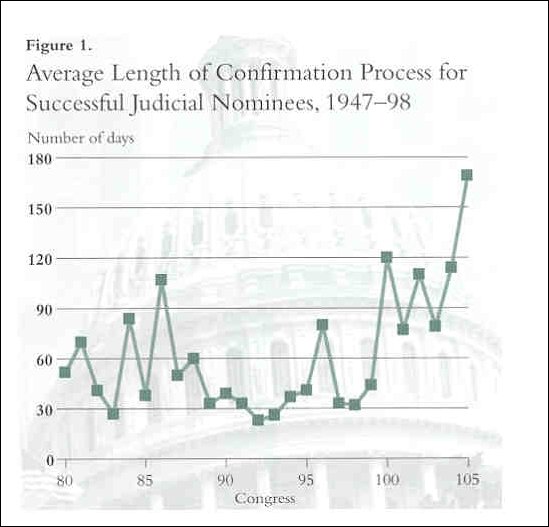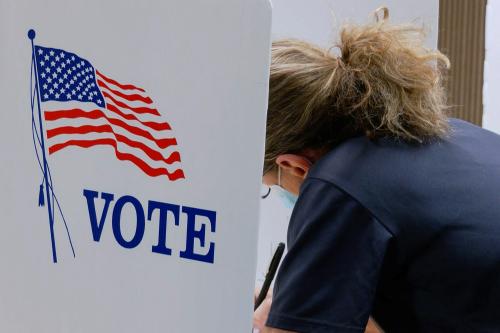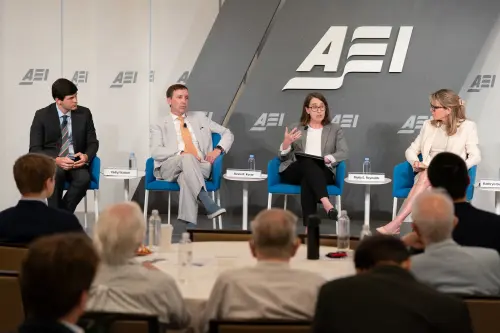For many a presidential appointee, the Senate must loom like an institutional black hole—an abyss that engulfs even the most luminous nominee. That impression is, in fact, mistaken. Most presidential nominees emerge from the Senate confirmation process and are eventually confirmed. But for many recent nominees, the experience has been long and unsettling.
Richard Paez, for example, a federal district court judge selected by President Clinton to fill a vacancy in 1996 on the pivotal Ninth Circuit Court of Appeals, had received the highest rating possible from the American Bar Association and been confirmed just two years earlier by a Democratic Senate for a seat on a federal district bench. Yet it took a Republican Senate more than four years to confirm his elevation to the appellate bench.
Is Paez’s confirmation experience typical? Are recent delays in the confirmation process for judicial appointees due mostly to antagonisms between President Clinton and the Republican Senate? Or are broader institutional and electoral trends at work? If so, what can other presidential appointees learn from the experience of judicial nominees? Although judges’ lifetime tenure on the federal bench and their broad policy jurisdiction distinguishes judicial nominees from all other appointees, no presidential appointee can afford to ignore the institutional and partisan hurdles that the Senate erects against presidential appointees seeking public service.
The Senate Record
 Judge Paez’s drawn-out confirmation, though extreme, reflects a broader trend under way in recent Congresses. Figure 1 shows how the confirmation process lengthened over the last half of the 20th century for all judicial nominees eventually confirmed by the Senate. Whereas the Senate took just one month to confirm the average judicial nominee during Ronald Reagan’s first term, by the end of Clinton’s second term the average wait had grown sixfold. At least one-third of Clinton’s judicial nominees in the 105th Congress (1997-98) waited more than six months to be confirmed, with the longest wait for a confirmed nominee stretching nearly the entire length of the Congress.
Judge Paez’s drawn-out confirmation, though extreme, reflects a broader trend under way in recent Congresses. Figure 1 shows how the confirmation process lengthened over the last half of the 20th century for all judicial nominees eventually confirmed by the Senate. Whereas the Senate took just one month to confirm the average judicial nominee during Ronald Reagan’s first term, by the end of Clinton’s second term the average wait had grown sixfold. At least one-third of Clinton’s judicial nominees in the 105th Congress (1997-98) waited more than six months to be confirmed, with the longest wait for a confirmed nominee stretching nearly the entire length of the Congress.
The delays Clinton weathered in getting his nominees confirmed to the bench are not simply a reflection of his polarized relations with a conservative Republican Senate. During the mid-1980s a Democratic Senate took an average of nearly four months to confirm judicial nominees of Presidents Reagan and Bush. And during 1993 and 1994, a Democratic Senate averaged three months in confirming Clinton’s nominees.
Indeed, although the politics of recent confirmations might be especially polarized, contentious relations between the Senate and the president go back a long way. During Dwight Eisenhower’s last term, for example, it took the Democratic Senate led by Lyndon Johnson an average of four months—and sometimes as long as seven months—to confirm judicial nominees.
The Politics of Senate Delay
By any measure, the Senate’s performance in dispensing advice and consent varied widely over the last half of the 20th century. How do we account for the uneven performance? Pundits assessing the Senate’s treatment of Clinton’s nominees typically point first to the poisoned relations between conservative Republicans and Clinton. It is often suggested that personal and political antagonisms between Clinton and hard-right conservatives led Republican senators to hold up unduly even the most highly qualified nominees. This may account for some of the delay, but hardly for all, since the trend toward lengthy confirmation proceedings was well under way before Clinton took office in 1993 and Republicans gained control of the Senate after the 1994 elections.
Others suggest that extreme delays encountered by judicial nominees in the 106th Congress owed much to the approaching presidential election. With control of both the Senate and the White House up for grabs in November 2000, it was natural for Republican senators to approach their confirmation duties with particular caution. Rather than confirming an outgoing Democratic president’s last judicial nominees, pragmatic politics would dictate that Republicans save these lifetime appointments for a president of their party. Not surprisingly, at the end of the 106th Congress, 40 judicial nominees remained in limbo. Most had not even received a hearing before the Senate Judiciary panel.
The historical record confirms that an approaching presidential election affects the politics of advice and consent. Over the past 50 years, the Senate has treated judicial nominations submitted or pending during a presidential election year differently than it has treated others. First, it has taken longer to confirm nominees pending before a presidential election than those submitted earlier in a president’s term. Second, and more notably, presidential-election-year nominees are much less likely to be confirmed, even controlling for the presence of divided government and the quality of the nominee. For all judicial nominations submitted between 1947 and 1998, nominees pending in the Senate before a presidential election were 25 percent less likely to be confirmed than nominees submitted earlier in a president’s term.
Divided party control of the White House and Senate also slows the confirmation process. Judges are policymakers as well as judicial arbiters with life tenure, giving senators good cause to scrutinize the views of all potential federal judges. Because presidents overwhelmingly seek to appoint judges from their own party, Senate scrutiny of judicial nominees should be particularly intense when two different parties control the White House and the Senate. It is no surprise then that the Senate has taken nearly 60 percent longer to confirm nominees during periods of divided government than during unified control. Judicial nominees are also less likely to be confirmed during divided government, even controlling for the quality of the nominee and other relevant factors.
Party politics also affects the course of nominations when presidents seek to fill vacancies on appellate circuits whose judges are evenly balanced between the two parties. Senate majorities are especially reluctant to confirm nominees to such courts when the appointment would tip the court balance in favor of a president from the opposing party. One of the hardest hit such courts is the Sixth Circuit Court of Appeals, straddling populous Midwestern states such as Michigan and Ohio. A quarter of the bench is vacant, including one seat declared a judicial emergency after sitting empty for five years. The Senate slowdown on appointments to the circuit likely was motivated by the strategic importance of the circuit, since confirming Clinton’s nominees would have deprived a Republican president of the opportunity to move a balanced court into the conservative camp. In short, electoral and partisan dynamics strongly shape the Senate’s conduct of advice and consent, making it difficult for presidents to stack the federal courts as they see fit.
Institutional Culprits
If elections alone were to blame for slow confirmations, presidential appointees might have little opportunity to hasten matters along. But the process of advice and consent is equally affected by an array of Senate rules, each of which distributes power in a unique way across the institution. Understanding chamber and committee rules is thus critical for any nominee preparing for Senate confirmation.
The first institutional hurdle for any nominee is the committee system charged with scrutinizing presidential appointees. Senate rules affect judicial nominees in committee in two ways. First, by tradition, senators from the home state of each nominee cast first judgment on potential appointees. The veto power of home state senators is institutionalized in Judiciary panel procedures, which allow them to register “blue slip” objections to judicial nominees referred to the committee. Although “negative” blue slips no longer kill a nominee outright, they weigh heavily in the committee chair’s assessment of whether, when, and how to proceed with a nominee.
Historically, big ideological differences between the president and the home state senator for at least appellate nominees have led to longer confirmation proceedings than normal, confirming the power of home state senators to affect panel proceedings. In practical terms, the strong support of a nominee’s home state senator is essential in gaining committee approval. Given the often fractured attention of the Senate and the willingness of senators to heed the preferences of the home state senator, having a strong advocate in the Senate with an interest in seeing the nomination proceed is critical. Although home state senators for executive branch nominees lack the leverage of a “blue slip,” securing a strong Senate sponsor can go a long way in greasing the skids in committee.
Second, Senate rules grant considerable procedural powers to committee chairs. Because of the generally low salience of most judicial nominations, the Senate largely defers to the Judiciary Committee’s judgment on whether and when to proceed with a nomination. The committee chair, who has the power to convene hearings and to hold a vote to report a nomination to the chamber, thus holds great discretion over the fate of each nominee. Not surprisingly, ideological differences between the Judiciary panel chair and the president affect discernibly the course of judicial nominations. The greater the ideological differences, the longer it takes the committee to act. And because all committee chairs retain agenda-setting powers, executive branch appointees are well served by establishing rapport with and support from the relevant panel chair.
Once approved by committee, however, a nomination must clear a second broad institutional hurdle: making it onto the Senate’s crowded agenda. By rule and precedent, both majority and minority party coalitions can delay nominations after they clear committee. Because the presiding officer of the chamber gives the majority leader priority in being recognized to speak on the Senate floor, the majority leader has the upper hand in setting the chamber’s agenda, especially given his control of the executive session agenda, the arena in which nominations may be called up for confirmation. When the president’s party controls the Senate, nominations are confirmed more quickly; under divided control, nominations can be kept off the floor by the majority leader. Such procedural advantages clearly enhance the importance of support from the majority leader in shaping the fate of presidential appointees.
But the majority leader’s discretion over the executive session agenda is not wielded without challenge, as nominations can be filibustered. That possibility usually motivates the majority leader to seek unanimous consent of the full chamber before bringing up a nomination. As a result, nominations are unlikely to clear the Senate without the endorsement of the minority party.
Given the de facto requirement of minority party assent, the party opposing the president retains power to affect the fate of nominees even when it does not control the Senate. As policy differences increase between the president and the opposing party, that party is more likely to exercise its power to delay nominees. Even controlling for the quality of the nominee and the many electoral factors shaping the confirmation process, ideological differences across the branches significantly slow and often derail judicial nominees.
Presidents and the Senate
Although presidents lack formal means of pushing nominations through to confirmation, they are not powerless in shaping how the Senate dispenses advice and consent. In the first place, better qualified nominees tend to sail more quickly through the Senate. At least in recent decades, a higher rating from the American Bar Association has often cut the time it takes judicial nominees to get confirmed and increased the probability of confirmation. The type of nominee appointed by the president, in other words, helps smooth the way to confirmation.
Presidents can also have tremendous impact on the fate of a nomination by strategically timing its referral to the Senate. As noted, nominations made earlier in a president’s term tend to move more swiftly than those made in a presidential election year. Nominations also take longer as the Senate gets mired in considering scores of appointees. The fewer nominees pending, the more quickly a nominee will be confirmed.
Perhaps surprisingly, there is little evidence that more popular presidents are able to get their nominees approved more quickly. That may be why presidents only rarely use their bully pulpit to draw attention to the plight of their nominees. In short, presidents have some influence over the speed of advice and consent, but their influence is exercised only at the margins of the legislative arena.
Help from the Stars?
It has been said that the Senate is composed of 100 atomic bombs, each of which can be triggered on a second’s notice. Perhaps—though the dozens of judicial nominees recently detained by senators in pursuit of assorted policy and political goals would suggest that a hostage-taking metaphor would be equally apt. Senator James Inhofe of Oklahoma certainly set a new standard in the wars of advice and consent when he held more than 30 judicial nominees hostage in a battle with the president over an unrelated recess appointment. Whether nominees are taken hostage as each party seeks action on blocks of nominees hanging in limbo before the Senate or whether nominees are simply used as pawns by senators trying to influence other matters of import to them, the low and uneven salience of most nominations encourages such hijacking, as senators rarely pay a political cost for holding up presidential appointees.
Though the Senate’s pattern of advice and consent may at times seem encumbered neither with rhyme nor with reason, more careful scrutiny suggests that Senate rules widely and predictably allocate influence across the Senate. With senators often willing to exploit their procedural rights, swift confirmation of presidential appointees, however well qualified, is rare. But for nominees navigating the shoals of the chamber, understanding the ways and means of Senate institutions is essential. Committee chairs, pivotal senators, and majority and minority party leaders alike wield considerable influence over the fate of presidential nominees. Cultivating support from these critical institutional players is essential in building a deliberate path toward confirmation. And a little help from the stars doesn’t hurt one bit.



Commentary
The Senate as a Black Hole: Lessons Learned from the Judicial Appointment Experience
March 1, 2001